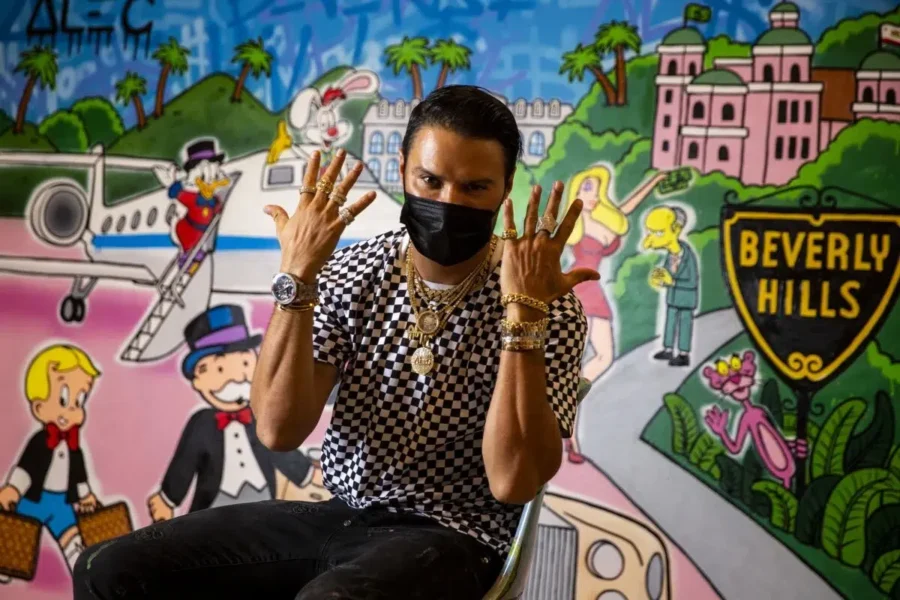The image is almost a caricature of contemporary art’s tangled dance with commerce: Alec Monopoly, the perpetually masked street artist, whose signature is the top-hatted, tuxedoed mascot of a game synonymous with capitalism, recently had his artwork prominently displayed on Jake Paul’s boxing shorts during a globally streamed Netflix event. This moment, like his high-profile collaborations with luxury watchmakers such as Jacob & Co. for a $600,000 timepiece , encapsulates the central provocation of his career. Alec Monopoly, the brand, thrives by deploying the iconography of anti-capitalist critique while simultaneously building a multi-million-dollar business. His work and persona sit at the contentious crossroads of street art, pop culture, luxury consumerism, and digital innovation, forcing a conversation about value, authenticity, and the evolving role of the artist in a hyper-commodified world. His cultivated anonymity, often maintained with a medical face mask or a strategically placed hand , once a practical necessity for a graffiti artist, now functions as a potent element of this brand, creating an “aura of intrigue” that paradoxically enhances his high public visibility and marketability.
From Street Tags to Tycoon Tropes: The Genesis of Alec Monopoly
Born Alec Andon in New York City to a mother who was a classically trained painter , the artist began his career with graffiti tagging in his youth. In 2006, he relocated to Los Angeles, a city he found more conducive to his burgeoning street art practice due to its sprawling billboards and, in his view, a less exclusive art scene than New York’s. This move predated the pivotal moment that would come to define his thematic concerns: the 2008 financial crisis. The economic collapse and the notoriety of figures like stockbroker Bernie Madoff served as a significant catalyst, pushing Monopoly to adopt the Parker Brothers board game character, Mr. Monopoly (Rich Uncle Pennybags), as his central figure, a direct visual commentary on financial systems, corporate greed, and the perceived absurdities of capitalism. This choice was not merely topical; it tapped into a widespread public anger and disillusionment, granting his early street art a populist resonance that extended beyond typical graffiti subcultures and laid the groundwork for his initial brand recognition.
His artistic style evolved from what was described as “primitive and impulsive” street graffiti into a more refined, pop-inflected aesthetic. He began incorporating varied materials such as stencils, spray paint, epoxies, varnishes, and newspapers. Alongside Mr. Monopoly, other iconic pop culture characters associated with wealth, such as Scrooge McDuck and Richie Rich, became staples in his compositions. This early adoption of recognizable figures demonstrated an understanding of pop art’s core mechanics: leveraging existing cultural symbols for immediate impact and broad appeal, making his work easily digestible and shareable. This accessibility would prove crucial for his later commercial business success. The transition from clandestine street work to the legitimate art market was marked by key events, including his first solo gallery show in New York City in November 2010 and his participation in Art Basel Miami Beach in December of the same year , signaling his arrival in the commercial art sphere.
Navigating Monopoly’s Board: The Current Landscape of an Art Brand
What began as an artist’s alias has since morphed into “Alec Monopoly,” a global brand and a sophisticated business enterprise. This enterprise is characterized by a prolific output of paintings, sculptures, and prints, alongside a diverse range of merchandise and an omnipresent media profile. Central to this operation is his representation by Eden Gallery, which hosts his exhibitions, such as the upcoming “The Garden of EDEN” in Miami (December 3–7, 2024) and “UNPERFECT EP III” in SoHo, New York (May 10–11, 2025), and facilitates sales, even pioneering innovative approaches like cryptocurrency-exclusive purchases.
High-profile collaborations are a cornerstone of the Alec Monopoly brand. He was named “art provocateur” by Swiss watchmaker TAG Heuer and has partnered with Jacob & Co. on ultra-luxury items like the $600,000 Astronomia Alec Monopoly watch. Other ventures include a limited-edition Whisky with Constellation X and, more recently, a foray into iGaming with PopOK Gaming for the “Eye on the Money” slot game and the Poly Live Casino Studio, launched in February 2025. The sheer diversity of these partnerships, extending from haute horlogerie to online gaming and influencer events like providing artwork for Jake Paul’s boxing attire , indicates a deliberate strategy to embed his brand across numerous cultural touchpoints, transcending the traditional art world to penetrate mainstream entertainment and lifestyle markets. This ambition suggests a desire to cultivate the art style itself into a widely recognized and monetizable asset.
The brand is further amplified by a roster of celebrity collectors, including names like Philipp Plein, Miley Cyrus, Snoop Dogg, and Adrien Brody , which significantly boosts his market visibility and desirability. His manager, Avery Andon, has spoken of a concerted effort to “establish Alec’s art as a luxury brand” and to meticulously “retain and nurture relationships with every one who acquires paintings,” particularly those making their first significant art purchase. This sophisticated approach to client acquisition and retention is more akin to that of a luxury goods firm than a conventional artist’s studio, highlighting a highly professionalized business operation.
Monopoly has also astutely embraced digital frontiers. His “Rags to Richie” NFT collection, comprising 3,333 unique digital artworks with over 150 attributes and 50 “legendary” pieces, launched on platforms like OpenSea and Rarible, signifies his engagement with Web3 and a tech-savvy collector base. This venture into the metaverse is thematically consistent with his April 2021 Eden Gallery exhibition, where new works were available for purchase exclusively using cryptocurrency. Monopoly himself framed this move as a critique of “antiquated financial systems,” stating, “Crypto is a modern way of doing business…it’s the way forward”. Such adoption is a dual strategy: it reinforces his brand‘s “disruptor” narrative while simultaneously tapping into new, lucrative markets. His active social media presence, notably an Instagram following exceeding 2 million , serves as a powerful, direct-to-consumer marketing and brand-building tool.
Market data indicates robust demand for his work, with pieces often commanding “high five to six-figure sums”. For instance, Heritage Auctions sold “Mr. Monopoly” for $51,250 and “Gold Bull” for over $75,000 in July 2020. While median auction prices fluctuate, MutualArt data shows a significant turnover in recent years, with 2024 showing an artist turnover of $356.32 (units likely in thousands, though unspecified) and a median price of $7,334.33.
To illustrate the strategic nature of his commercial activities, the following table outlines selected recent ventures:
| Year | Venture/Collaboration | Type | Significance to Brand/Business |
|---|---|---|---|
| 2021 | Eden Gallery Crypto-Exclusive Sale | Exhibition/Sale | Pioneering cryptocurrency adoption in his market, reinforcing anti-establishment brand narrative. |
| 2021 | Jacob & Co. Astronomia Watch | Luxury Product Collab | Association with ultra-high-end luxury, significant price point ($600k). |
| 2022 (Launched) | “Rags to Richie” NFT Collection | Digital Art/NFT | Expansion into Web3, engaging new collector base, digital branding. |
| 2023 (Ongoing) | TAG Heuer Ambassadorship | Luxury Brand Ambassadorship | Sustained partnership with major luxury watchmaker, “art provocateur” title. |
| 2024 (Nov) | Jake Paul Boxing Shorts Artwork | Event/Media Placement | High visibility pop-culture moment, aligning with influencer culture. |
| 2025 (Feb) | PopOK Gaming “Eye on the Money” & Casino Studio | iGaming Collaboration | Diversification into new entertainment sectors, leveraging art style for interactive experiences. |
Critical Perspectives: Reading Between the Dollar Signs
The meteoric rise and pervasive commercialism of Alec Monopoly have inevitably drawn critical scrutiny. The central debate revolves around a fundamental question: does his art genuinely subvert the capitalist structures it references, or does it merely aestheticize and ultimately profit from them? His style, which liberally co-opts symbols of wealth and corporate power, is at the heart of this discourse.
Accusations of “selling out” are common, particularly from commentators who contrast his current blue-chip status with the ostensibly rebellious roots of street art. The blog Vandalog, for instance, has offered scathing critiques, asserting that Monopoly’s work is “pop art solely for the sake displaying money and celebrity” and that the artist “doesn’t understand the meaning of…subversive”. One Vandalog piece even claims Monopoly admitted his art was primarily a “money-making/get-laid scheme”. Such criticisms question the depth and sincerity of his social commentary.
Originality is another point of contention. Some in the art community query whether the repetitive use of pop culture figures like Mr. Monopoly, Scrooge McDuck, and Richie Rich constitutes fresh artistic interpretation or simply a leveraging of familiar icons for easy market appeal and brand recognition. The Monopoly Man, as his primary icon, is a particularly effective semiotic device: it is a globally recognized symbol of capitalism that he can endlessly re-contextualize. This allows his art to appear critical, yet the character’s playful, almost nostalgic nature ensures it remains commercially palatable, even to collectors who are themselves beneficiaries of the systems ostensibly being critiqued.
In defense, supporters and the artist himself often frame the work as satirical and playful, intended to make complex socio-economic issues accessible to a wider audience. Monopoly has stated he uses these characters to “remind the general population that we are all a part of game that anyone of us can win”. His “lighthearted approach” is seen by some as a way to engage viewers who might be alienated by more overtly aggressive forms of critique. It is noteworthy that the very act of debating Monopoly’s authenticity and critical merit has, in a way, become integral to his brand and market strength; controversy generates discourse, which in turn maintains his visibility and reinforces his image as a “provocateur” , irrespective of the intended nature of that provocation.
Comparisons to other artists are frequent. He is often likened to Banksy due to their shared street art origins and the use of stencil-like imagery to comment on societal issues. However, Banksy has largely maintained a more overtly anti-establishment stance and a more rigorously guarded anonymity, whereas Monopoly’s embrace of commercial opportunities is far more conspicuous. The parallel with Andy Warhol is also commonly drawn, given the pop art style, the focus on iconic imagery, and the immense commercial success. Warhol famously embraced mass production, branding, and the commodification of his art , effectively turning himself into a brand. Whether Monopoly is simply following Warhol’s blueprint or forging a distinct path in the interplay of art and commerce remains a key point of discussion.
Speculative or Forward-Looking Analysis: The Future of the Game
Looking ahead, Alec Monopoly’s trajectory suggests continued evolution and diversification. There are indications he is exploring “more politically charged content and environmental themes” in his recent work. Such a pivot could be a strategic move to deepen the perceived critical substance of his art, broaden his appeal to new audiences, and perhaps counter criticisms of superficiality. This would be a significant development for his brand, potentially reshaping his legacy if pursued with authentic commitment.
His deep integration of digital technologies is almost certain to expand. The “Rags to Richie” NFT collection and his adoption of cryptocurrency for sales are likely precursors to further ventures in the metaverse and with emerging digital platforms. This aligns perfectly with his agile business model of identifying and capitalizing on new market trends and technologies.
Beyond visual art, Monopoly’s brand is branching out. He is an active DJ , launched a swimwear collection with renowned chef Nobu Matsuhisa , and there has been mention of a potential collaboration with Disney and the establishment of an “Alec Monopoly Foundation supporting young artists”. The creation of such a foundation, if realized, would be a conventional yet effective strategy for cementing a positive legacy, potentially softening his commercially driven image and aligning him with philanthropic endeavors common among successful entrepreneurs. His expressed interest in focusing on sculptures, particularly in bronze, because “they feel like they’re something that lasts forever” , also signals a conscious effort to create works with greater perceived permanence and art-historical weight, directly addressing questions about his long-term artistic legacy.
The sustainability of the high demand and market prices for his work will depend on his ability to continuously innovate and adapt in a constantly shifting cultural and economic landscape. His legacy is thus a work in progress, contingent on these future moves and their reception.
Beyond Park Place and Boardwalk
Alec Monopoly remains an embodiment of the contemporary art world’s intricate dance with capitalism, an artist who critiques the system using its own lexicon and symbols, achieving remarkable commercial success in the process. His career serves as a potent case study in the fusion of art, brand, style, and business, exemplifying the rise of the artist as a multifaceted entrepreneur and media phenomenon. He has, in many ways, provided a blueprint for leveraging pop culture, strategic branding, and new media to achieve global recognition and commercial success, often bypassing traditional art world gatekeepers.
His trajectory compels a re-evaluation of authenticity, the complex dynamics of commodified critique, and the ever-shifting boundaries of what constitutes art and artistic practice in the 21st century. The unresolved tension in his work, the oscillation between critiquing and celebrating wealth, mirrors a broader societal ambivalence towards capitalism, making his art a reflective surface for contemporary cultural anxieties and aspirations. Ultimately, whether Alec Monopoly’s legacy will be primarily defined by his savvy brand-building, his distinctive pop art provocations, his role as a genuine (if contentious) commentator on our times, or a complex amalgam of all these, is a narrative still unfolding. His influence, as noted by IMDB, is “undeniable” , and his “crossover appeal…demonstrates the shifting boundaries of contemporary art” , leaving ample room for continued discourse and future assessment.










